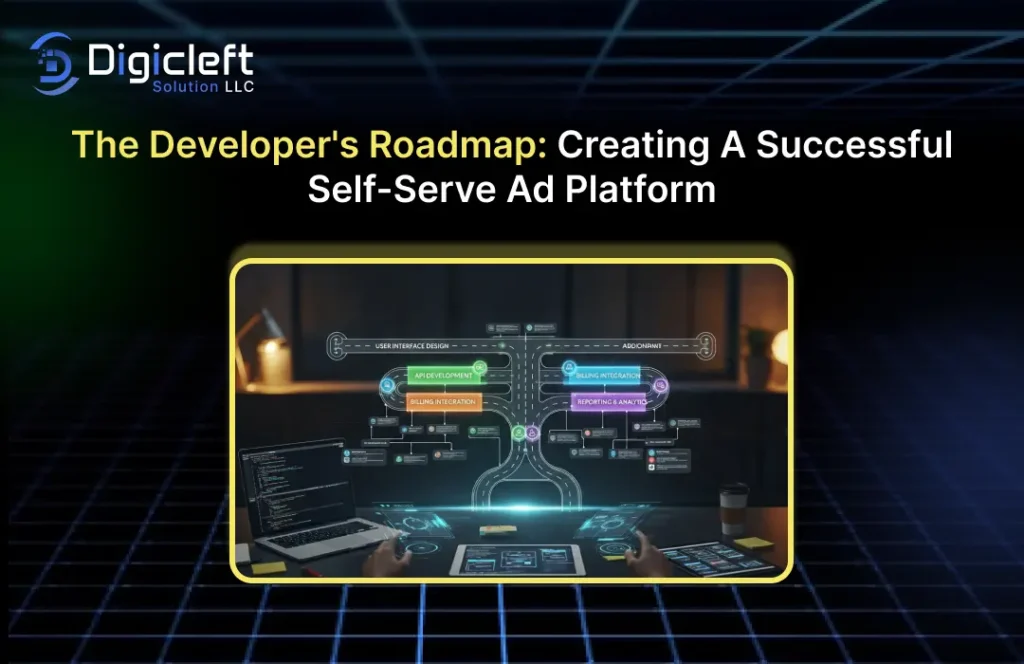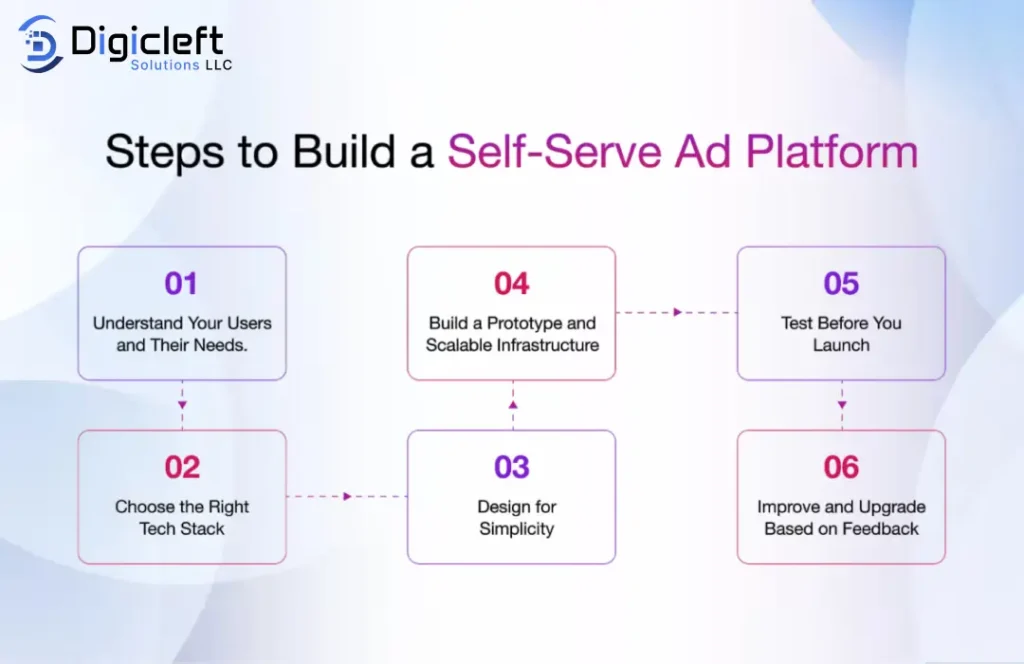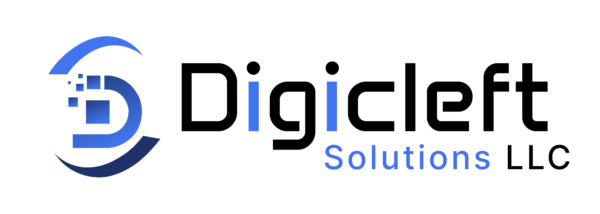
Hey there, fellow tech enthusiasts and aspiring digital innovators! If you’ve ever dreamed of building your own self-serve ad platform, you’re in for a wild and rewarding ride. With digital advertising growing at lightning speed, self-serve solutions are the golden ticket for developers and businesses alike. This guide will break down the roadmap you need step by step to create a successful self-serve ad platform, sprinkled with real-world insight, personal tone, and, of course, that secret sauce: digicleft solution.
What Is a Self-Serve Ad Platform?
Definition and Overview
In simple terms, a self-serve ad platform allows advertisers to independently create, manage, and track their ad campaigns without relying on account managers or third parties. Think Google Ads or Facebook Ads Manager but you’re building your own version, tailored to your audience and business goals.
Why Self-Serve Ad Platforms Are Gaining Popularity
Why the buzz? Well, the answer is pretty straightforward: flexibility, speed, and cost-effectiveness. Advertisers love the autonomy. No more waiting for someone else to set up their campaign. It’s instant, easy, and efficient.
Why Developers Should Build Their Own Self-Serve Ad Platform
The Rise of Programmatic Advertising
Programmatic advertising—automated, data-driven buying and selling of ad space is transforming the industry. As a developer, tapping into this wave can position you at the forefront of ad tech innovation.
Control and Flexibility
By building your own platform, you decide how features work, what integrations to use, and what limitations (or freedoms) you impose. This control leads to highly customizable solutions that fit niche markets.
Cost-Effectiveness
Sure, big players have huge infrastructures. But small to medium businesses (SMBs) want simplicity and lower costs. Creating a self-serve platform using a digicleft solution can dramatically reduce operational overhead, offering an affordable product.
Key Features Every Self-Serve Ad Platform Needs
User-Friendly Dashboard
A slick, intuitive dashboard is a must. Think drag-and-drop campaign builders, easy-to-read graphs, and zero jargon.
Campaign Creation Tools
Advertisers need flexibility to design ads: set budgets, choose creatives, define audience segments, and schedule campaigns.
Real-Time Analytics
Nothing beats instant feedback. Track impressions, clicks, CTR, and ROI live, helping advertisers tweak their strategies on the fly.
Payment Gateway Integration
Let’s face it—without easy payments, you’re toast. Secure and diverse payment options are critical for smooth monetization.
Targeting and Segmentation Options
Geo-targeting, demographic splits, device types provide enough targeting options so advertisers feel empowered without being overwhelmed.
The Technical Roadmap: Step-by-Step Approach

Step 1: Define Clear Objectives
What are you solving? Pin down your unique selling proposition (USP). Are you focusing on SMBs, niche markets, or broad enterprise clients?
Step 2: Choose the Right Tech Stack
Go for robust backend frameworks like Node.js, Django, or Ruby on Rails. For the frontend, React or Vue.js ensures dynamic interfaces. Don’t forget databases PostgreSQL or MongoDB come highly recommended.
Step 3: Build the Core Backend System
This is the engine room. Set up ad inventory management, user authentication, bidding logic, and campaign storage. Ensure APIs are clean, efficient, and documented.
Step 4: Design an Intuitive Frontend Interface
An ad platform is only as good as its ease of use. Design for simplicity: drag-and-drop features, step-by-step wizards, and real-time preview of ads.
Step 5: Implement Real-Time Bidding (RTB) Features
RTB enables multiple advertisers to bid on the same ad impression in real-time. It’s complex but essential for maximizing revenue. Tools like Apache Kafka and Redis can handle message queuing and speed.
Step 6: Ensure Scalability and Performance
Expect growth. Build microservices architecture, use containerization (Docker), and host on cloud solutions (AWS, GCP). Performance tuning and load testing are non-negotiable.
Challenges Developers Face During Development
Security Concerns
With great power comes great responsibility. User data, payment info, and ad content need solid encryption, secure API endpoints, and GDPR compliance baked in from day one.
Handling Large Data Volumes
Ads generate massive data: impressions, clicks, logs. Make sure your data pipeline can handle millions of events per second without bottlenecking.
Balancing Flexibility vs Simplicity
Too many features can overwhelm users; too few, and they’ll leave. Finding that sweet spot is more of an art than science.
Leveraging Digicleft Solution for a Seamless Experience
Here’s the insider tip: integrating a digicleft solution makes your life a lot easier. It simplifies complex ad-serving logistics, provides plug-and-play modules for targeting, and enhances system reliability. No need to reinvent the wheel when digicleft solution already offers robust, scalable, and customizable options. Developers can focus on creating unique features rather than struggling with basic ad management infrastructure.
Testing and Iteration: Why It’s Crucial
Don’t launch and pray. Test your platform extensively:
- Load testing to simulate thousands of users
- A/B testing to see what works best in the dashboard UI
- Security audits to prevent vulnerabilities
Iterate based on feedback. Think of your platform as a living organism—it needs constant care.
Marketing Your Self-Serve Ad Platform
Building a Brand
Your platform needs personality. Be clear about your USP and build consistent messaging that appeals to your target audience.
Creating Developer Communities
Nothing beats word-of-mouth in tech. Launch forums, Slack channels, and GitHub repos where developers can share ideas, report bugs, and suggest features.
SEO and Content Marketing
Blog about success stories, how-to guides, industry insights drive organic traffic. Optimize for keywords like “self-serve ad platform,” “programmatic advertising solutions,” and “digicleft solution.”
Measuring Success: KPIs to Track
User Engagement
How often do advertisers log in? How long do they stay? Engagement signals platform stickiness.
Ad Spend and Revenue
Track total ad spend, average spend per campaign, and your revenue share.
System Uptime
Downtime kills credibility. Monitor uptime, API response times, and error rates with tools like New Relic or Datadog.
Case Studies of Successful Self-Serve Ad Platforms
Let’s look at a few big names:
- Google Ads: A pioneer of self-serve models. Massive scale, high reliability, and deep targeting.
- Facebook Ads Manager: User-friendly interface with powerful segmentation tools.
Smaller but successful platforms often lean into specific industries or markets, and integrating a digicleft solution makes this process smoother, faster, and more cost-efficient.
The Future of Self-Serve Ad Platforms
AI-Powered Automation
AI is making ad creation smarter—predictive targeting, automated creatives, bid optimization. You don’t just build a platform; you build a smart companion for advertisers.
Enhanced Personalization
Imagine every advertiser having a dashboard tailored to their industry and ad history. Digicleft solution helps you layer in personalization effortlessly.
Privacy and Compliance
GDPR, CCPA, and other regulations are no joke. Building privacy-first architecture isn’t optional; it’s mandatory.
Conclusion
Creating a self-serve ad platform isn’t just coding it’s about building an experience. From intuitive dashboards to real-time bidding engines and powerful analytics, each piece of the puzzle must fit together seamlessly. And don’t forget to leverage the digicleft solution to streamline development, save time, and focus on what matters: giving your users the power to run their own ads effortlessly. So, are you ready to get your hands dirty and build the next big thing in ad tech?
FAQs
1. What makes a self-serve ad platform different from traditional ad networks?
A self-serve platform gives advertisers full control to create and manage ads without human intervention, unlike traditional networks where account managers mediate the process.
2. How does the digicleft solution simplify platform development?
It provides plug-and-play modules that handle core ad-serving functionalities, so developers don’t have to start from scratch.
3. Do I need advanced technical knowledge to build a self-serve ad platform?
Yes, a solid grasp of backend and frontend development, databases, and APIs is essential, though solutions like digicleft reduce complexity.
4. How important is real-time analytics for advertisers?
Extremely important. Advertisers rely on instant data to optimize campaigns on the fly and maximize ROI.
5. What are the biggest challenges in building a self-serve ad platform?
Security, scalability, handling large data volumes, and maintaining user-friendly design while offering powerful features.


